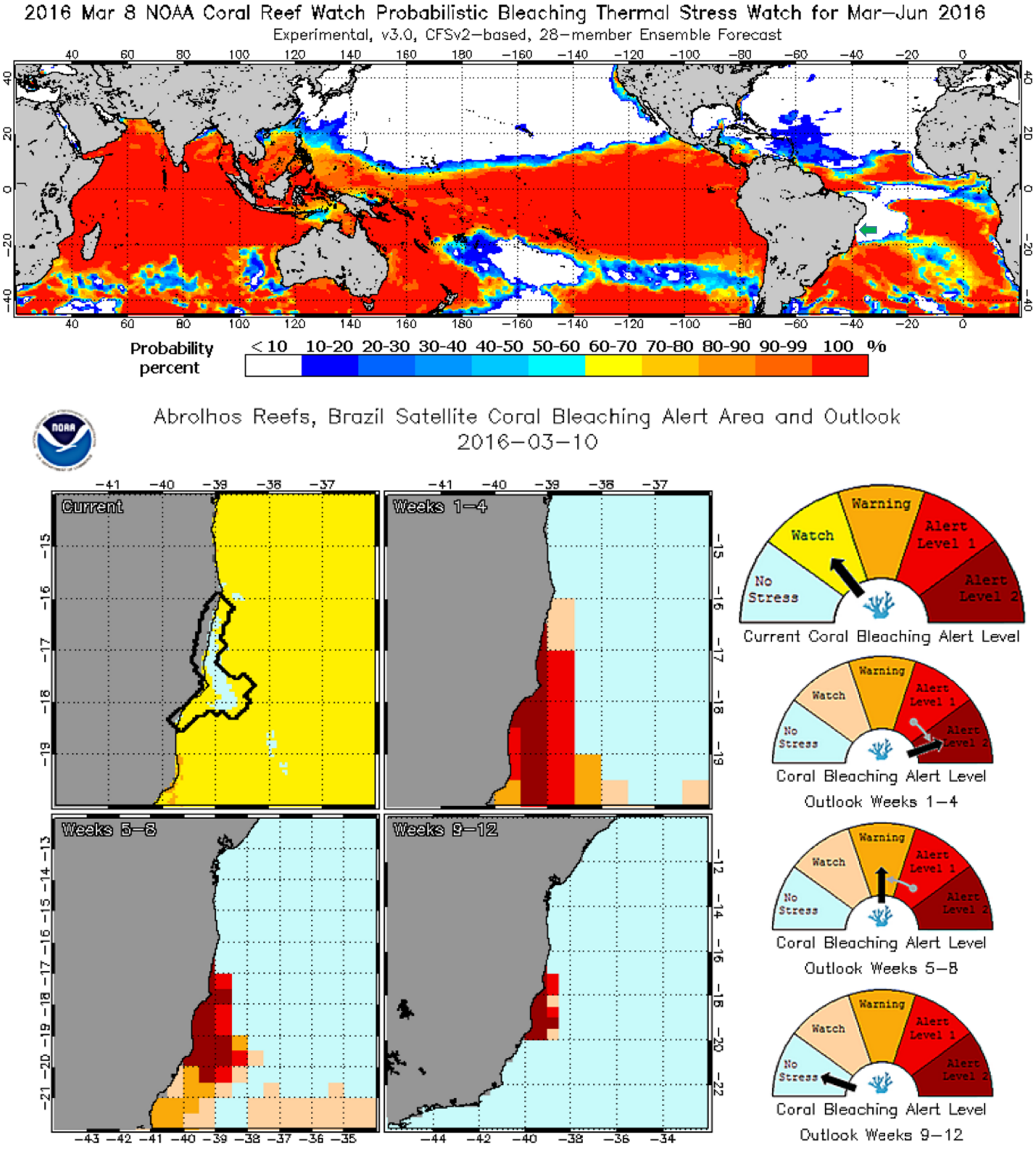The third global Coral Bleaching event is still out there, and is already the longest event of the type in history (1). It has affected multiple reef areas causing enormous damage is many (e. g. 2), and might still cause a lot of damage (1) what is very sad for the already endangered coral reef ecosystems. In 2016, some areas are still predicted to suffer with the thermal anomalies (see figure 1, upper image), what is the main cause of coral bleaching, extending this event even more and causing greater concern for the conservation of the beautiful and diverse reefs.
Although the event is still going on, the forecast for some areas has changed, and the event can be either tougher or milder than expected. South Atlantic, where the Abrolhos Marine National Park is at, is always expected to be affected between March and May (3), months in which thermal anomalies occur in that area of the ocean, and that is what was predicted by NOAA in the last few months.
However, Southwest Atlantic did not read their forecast, and is behaving a bit differently than expected. The NOAA`s probabilistic bleaching thermal stress watch graph (figure 1, upper image) shows that the area is an “island of stability” amongst a global belt of unfavorable forecast in the tropical areas. Other previous graphs had this area as a milder target (alert level 1), but now, for the happiness of coral reefs in the area, chances are lower.

Figure 1: NOAA`s previsions on Coral Bleaching. Upper image: NOAA Coral Reef Watch Probabilistic / Bleaching Thermal Stress Watch. Probability of Thermal Stress is very high for most areas in the Tropics. Note that Southwest Atlantic and some parts of South Pacific are stability Islands with lower probability. Green Arrow shows approximate position of the Abrolhos Marine National Park. Lower Images: Satellite Bleaching Alert and Outlook. Abrolhos area is inside black lines in upper left square (Current). Note the stability island inside the area. Dark red and red patches starting in the next weeks in the area show that thermal stress is likely to hit the area. In Lower Right image (Weeks 9-12), Note that the Park is going to be in a Hot Spot. Images adapted from and available at 5 and 6
However, everything isn`t flowers. Although reefs in Northeast Brazil are likely safe for now, Abrolhos is further south, and an “arm of instability” may affect Brazil`s lower coast, having the Abrolhos` area as its end (see lower figure 1). If the forecast is accurate, the sanctuary, which is house to all hard coral species in South Atlantic (4), should face in the next two months a somewhat intense hot spot, putting the area in Alert. Nonetheless, the Current thermal map in the area shows the park as “Watch”, relatively close to a stability island, requiring the pattern to reverse for the previsions to become reality.
Whether the reefs bleached or not in the last 1 month of “Watch”, of if it is going to bleach in the next expected month of instabilities, we don`t know yet. However, coinciding with the previsions of greater possible damage, there are planned expeditions. Researchers of Federal University of Bahia (UFBA), led by Dr. Kikuchi and Dr. Leão will visit the Marine National Park in two weeks, and reports on how the reef responded to recent events should be available from then. Amid so many disastrous effects of the bleaching in the globe, we hope that that area is not affected, and remains as a refuge for reefs in the region.
References
[1] Slezak, M. (2016). Available at http://www.theguardian.com/environment/2016/feb/23/global-coral-bleaching-event-threatens-great-barrier-reef, accessed in 3/13/2016
[2] Marszal, A. (2014). Available at http://www.telegraph.co.uk/news/worldnews/australiaandthepacific/marshallislands/11308173/Global-warming-blamed-for-worst-ever-Marshall-Islands-coral-bleaching.html, accessed in 3/13/2016
[3] Leão, Z., Kikuchi, R., Oliveira, M., & Vasconcellos, V. (2010). Status of Eastern Brazilian coral reefs in time of climate changes. Pan-American Journal of Aquatic Sciences, 5(2), 224–235. http://doi.org/10.1016/B978-044451388-5/50003-5
[4] Leão, Z.M.A.N., Kikuchi,R.K. and Testa,V., (2003). Corals and coral reefs of Brazil. In Latin American Coral Reefs, J. Cortés (Ed.), pp. 9–52 (Amsterdam: Elsevier). In In Krug, L. A., Gherardi, D. F. M., Stech, J. L., de Andrade, Z. M., & de Kikuchi, R. K. P. (2012). Characterization of coral bleaching environments and their variation along the Bahia state coast, Brazil. International Journal of Remote Sensing, 33(13), 4059–4074.http://doi.org/10.1080/01431161.2011.639505
[5] http://coralreefwatch.noaa.gov/vs/gauges/abrolhos_reefs.php, accessed in 3/13/2016
[6] http://coralreefwatch.noaa.gov/satellite/bleachingoutlook_cfs/current_images/cur_img_v3_ss_watch_outlookprob_cfs_45ns.gif, accessed in 3/13/2016

